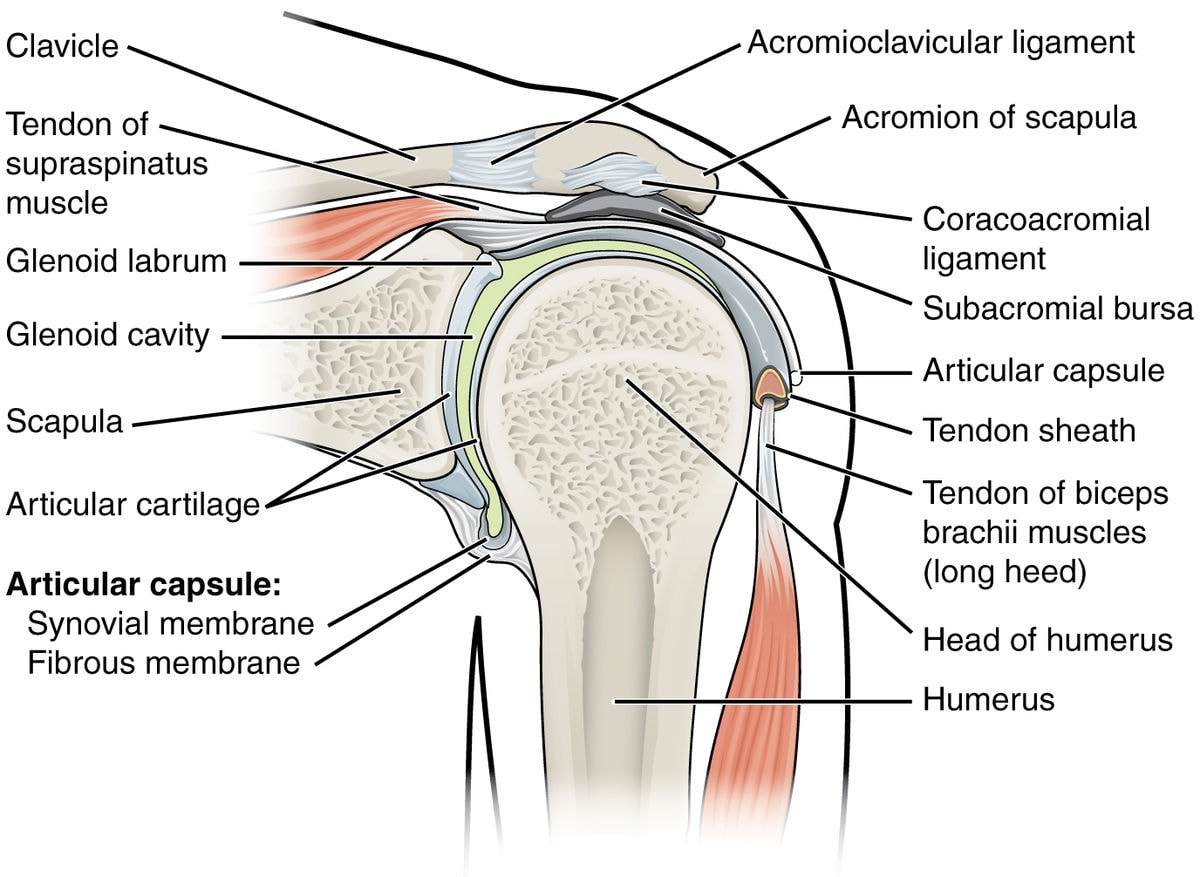
Shoulder pain can significantly impact daily life, making even simple tasks like dressing, lifting, or reaching overhead difficult. Shoulder problems, including dislocations, degenerative issues, and pain caused by overuse or injury, can interfere with work, sleep, and recreational activities, often leading to frustration and decreased quality of life. When left untreated, shoulder pain may limit mobility and strength, hindering your ability to maintain an active lifestyle or even deal with everyday life. Addressing the root cause of shoulder pain is essential for restoring function, improving comfort, and preventing long-term complications.
Shoulder conditions and injuries can affect many different parts of the shoulder including structures such as muscles, joints, nerves and sometimes a combination. Common issues include:
- Rotator cuff tear, which often result in weakness and reduced shoulder movement,
- Bursitis, where inflammation and structural changes cause discomfort and limited mobility,
- Tendinopathy, often due to overuse, leads to stiffness and pain during movement,
- Frozen shoulder, or adhesive capsulitis, results in severe stiffness and restricted motion,
- Dislocations can cause injury to structures and result in shoulder instability.
- Osteoarthritis
Understanding Shoulder Pain
Shoulder pain is a widespread issue that affects millions of people globally. The shoulder joint is a marvel of human anatomy, designed to provide a wide range of motion. However, this complexity also makes it vulnerable to various injuries and conditions. The shoulder joint comprises bones, muscles, tendons, and ligaments that work in harmony to facilitate movement. When any of these components are compromised, it can lead to significant discomfort and limited functionality. Understanding the intricate nature of the shoulder joint is crucial in recognizing why shoulder pain occurs and how it can be effectively managed.
Anatomy of the Shoulder and Rotator Cuff
The shoulder is a highly complex and mobile ball and socket joint made up of three main bones: the humerus (upper arm), scapula (shoulder blade), and clavicle (collarbone). These bones form two key joints—the glenohumeral joint, where the ball of the upper arm bone fits into the socket of the shoulder blade, and the acromioclavicular joint, where the collarbone meets the shoulder blade. The rotator cuff, a group of muscles and tendons, surrounds the shoulder joint, providing stability and facilitating movement, while the larger muscles of the back, chest and shoulder provide higher level strength and power. Ligaments, bursae (fluid-filled sacs), and cartilage further support the shoulder, enabling its wide range of motion while maintaining strength and flexibility.


Common Causes of Shoulder Pain
Several common causes can lead to shoulder pain, each affecting the shoulder joint in different ways:
- Rotator Cuff Tendinopathy or Tears: The rotator cuff is a group of muscles and tendons that stabilise the shoulder joint. Cellular change or tears in these rotator cuff tendons can result in pain and weakness, making it difficult to perform everyday tasks.
- Shoulder Impingement: This condition occurs when the rotator cuff tendons of the become inflamed or damaged, leading to pain and restricted movement of the arm.
- Frozen Shoulder: Also known as adhesive capsulitis, this condition causes the capsule around the shoulder joint to become too tight, severely limiting movement and causing significant pain.
- Osteoarthritis: A common degenerative condition that can affect any joint, including the shoulder. It leads to the thinning of cartilage and the formation of tiny bone spurs, causing pain and stiffness.
- Rheumatoid Arthritis: An inflammatory type of arthritis that can affect the shoulder joints, leading to inflammation of the joint lining and causing pain and swelling.
- Dislocations: Where the head of the humerus dislodges from the shoulder blade, usually either in a forward and down position or occasionally backwards. Dislocations can spontaneously relocate, or require relocation by a trained professional.
- Subacromial Bursitis: Inflammation and structural changes to the bursa and cause discomfort, pain and limited mobility.
Understanding these common causes can help in identifying the source of shoulder pain and determining the appropriate treatment.
Diagnosing Shoulder Pain
Diagnosing shoulder pain involves a comprehensive approach that includes medical history, physical examination, and various tests. Depending on your condition, the severity of your signs and symptoms and whether we need to rule other things out, imaging may also be required.
Medical History and Physical Examination
A detailed medical history is the first step in diagnosing shoulder pain. Your physiotherapist will inquire about your symptoms, such as when they began, their duration, and any activities that worsen or alleviate the pain. They will also review your medical history, including any previous injuries or conditions that might be contributing to your shoulder pain.
During the physical examination, your physiotherapist will assess the range of motion and strength of your shoulder joint. They may perform specific tests, such as the Neer test or the Hawkins-Kennedy test, to check for signs of rotator cuff tendinopathy or tears. These tests help pinpoint the exact cause of the pain and guide further diagnostic steps.

Tests and Imaging
In some cases, additional tests and imaging may be necessary to confirm the diagnosis or rule out other conditions. These may include:
- X-rays: Useful for detecting bone fractures or signs of osteoarthritis.
- MRI: Provides detailed images of the rotator cuff tendons, joint capsule, and surrounding tissues, helping to identify tendinopathy or tears.
- CT Scan: Offers a detailed view of the bones and can help diagnose fractures or osteoarthritis.
- Electromyography (EMG): Assesses muscle weakness or nerve damage, providing insights into the extent of the injury.
Treatment for shoulder pain will depend on the underlying cause and may include physiotherapy, painkillers, and in some cases, surgery. It’s essential to seek medical attention if you’re experiencing severe pain or difficulty moving your arm. Early diagnosis and intervention can lead to better outcomes and prevent long-term complications.

Physiotherapy Treatment for Shoulder Pain
Physiotherapy provides a comprehensive, stepped approach to managing shoulder pain. Initially, manual therapy and targeted pain management techniques are often used to reduce discomfort, restore some mobility and make life a little more comfortable. As pain improves, treatment focuses on improving the shoulder’s range of motion through stretching and gentle mobility exercises. As mobility is restored and your shoulder can handle more load, progressive strengthening exercises are introduced to build stability and muscle strength. All of which enhances function and helps prevent future injuries.
When to see a Physiotherapist for shoulder pain
You should consider seeing a physiotherapist for shoulder pain if the discomfort persists for more than a few days, significantly restricts your movement, or worsens over time. If you experience sharp pain during activities, swelling, or difficulty performing daily tasks like reaching overhead, it may indicate a more serious issue. Other signs that indicate a need for further investigation include weakness, pins and needles, numbness or tingling. Physiotherapists are trained in the diagnosis of shoulder conditions and can provide tailored individual treatment to manage pain, restore mobility, and prevent further injury. Early intervention with physiotherapy treatment can lead to faster recovery and reduce the risk of chronic pain or long-term damage.
Helpful Tips to Reduce your Shoulder Pain
Shoulder pain can be challenging to reduce as we use our shoulders for so much of our daily lives – even when sitting at your desk, your shoulder is working at a low level. This is often why it’s not too painful to start, but builds over time.
Step 1: Understand your painful patterns. By this we mean understand what makes your pain worse, but also what makes it better. Sometimes we can’t avoid the things that make it hurt, but if we know that task is approaching, we can aim to be ‘nicer’ to our shoulder beforehand so it’s less angry at the start of the task. After we’ve completed the task, we can then use our knowledge of what makes it better to help calm it down. Some examples might be positioning (such as lying down), direct ice or heat (they work differently for different people), hot shower, stretching or a massage.
Step 2: Load management. It’s inconvenient, but at the end of the day, if something is making your shoulder hurt, most of the time you’ll have to find a way of either reducing that activity for a while or changing it so that it’s less painful to perform. If we do less stuff over a day that makes our shoulder cranky, then it’s likely going to feel better at the end of the day.
Step 3: Exercise. Slowly improve the quality and capacity of the injured or irritated tissues so that they can deal with the demands of your work, life and hobbies.
How long will my Shoulder pain last
This depends on so many variables including your specific injury/condition, its severity, your lifestyle and your health. Once you understand your specific shoulder condition and get a handle on your painful patterns we mentioned earlier things can often start to settle fairly quickly. Even the most grumpy and painful shoulders can see positive change in as little as 1-2 weeks.
If we consider the entire spectrum of your shoulder rehab – pain management, returning of mobility and then strengthening, it is usually a 3-6 month journey. This sounds like quite a long time, but it’s important to remember a few things:
- Often people don’t come to see us early on, so we’re dealing with increased irritation, changes in tissues and strength that take time to improve.
- There are often positive changes from early on, so even 3 or 4 weeks into your shoulder rehab journey, you’ll be feeling 10 times better than you were at the start.
Preventing Shoulder Joint Injuries
There’s no way around it, injury prevention is complicated, but we believe in a balanced and logical approach – sorry, no hyperbolic claims that we have THE BEST exercise to ensure you never experience a shoulder injury ever again 😉
In short, we think ‘physical preparedness’ is the best way to model your shoulder pain prehab. Think about the tasks that your life, sport or hobbies require of your shoulder, and then make sure you address the specifics of those movements regularly to ensure your shoulder joint, muscles, cartilage, nerves etc are all primed, ready for action and more resistant to shoulder injuries.
Below is a short list of some of the things we consider when building a shoulder injury prevention program for our clients:
- You as an individual – work, home life, likes/dislikes, hobbies etc.
- Strength
- Endurance
- Range of motion
- Speed of movement
- Planes of movement
- Kinetic chain (fancy term for considering other parts of your body that have to help in order for your shoulder to perform at its best)
- Peak forces
- Rates of acceleration and deceleration

Can shoulder pain be treated without surgery
In many cases, yes! This is often termed ‘conservative management’. In short, it involves many of the things we’ve already discussed in this article. Interestingly, pre-operative physiotherapy also involves many of the above treatments and concepts, so undertaking a period of conservative management is a great first step. If you’re successful and your shoulder pain and function improves to a point where you’re satisfied, then happy days, no need for surgery!
If your shoulder doesn’t quite improve enough and you opt for surgery, then your period of conservative management has actually also been your pre-operative physiotherapy. This means you enter surgery with a shoulder that is more robust than early on in your pain/injury journey and you’ll be glad to hear we often see improved post-surgical results when patients have done a period of pre-operative physiotherapy. This approach is also beneficial for conditions like shoulder dislocation, where initial treatment may involve closed reduction, immobilization, and follow-up physical therapy to prevent recurring issues.
Our Principal Physio, Matt has a special interest in treating shoulders so if you’d like to get to the bottom of your shoulder pain, we’d love to see you in our clinic.